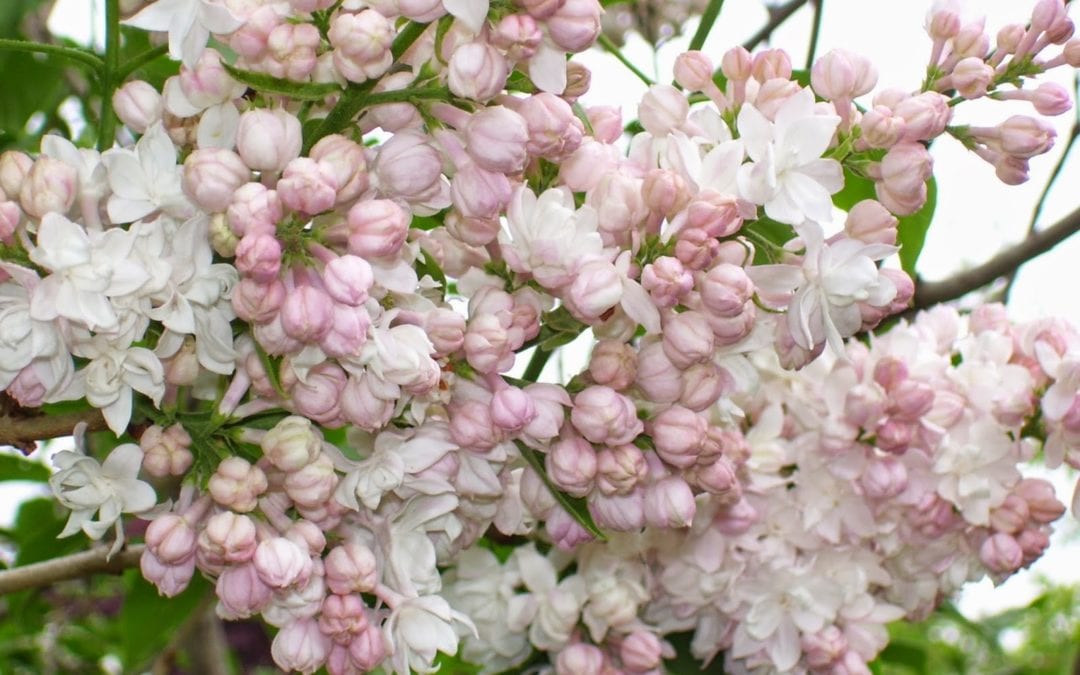Imagine an old-fashioned garden. Maybe you can feel the warm spring breezes on your face. As you settle into the fantasy, is there a fragrance that comes to mind? I’d bet that you’re breathing in the memory of a lilac in full bloom. The scent can be intoxicating and the range of soft pink, cool blue, and intense magenta hues have made lilacs a favorite of artists, both in and out of the garden, for centuries.
When most of us consider planting a lilac in the garden, we’re usually thinking of the common lilac, Syringa vulgaris, a native in the mountains of southwestern Europe. Grown in gardens since the 1500’s, horticulturalists began hybridizing for color and fragrance in the early 19th century. In the United States, Father John Fiala, a priest, and educator in Ohio founded the International Lilac Society, and introduced several varieties that were considered especially fragrant. One of his best-known selections is the intensely deep purple ‘Yankee Doodle’, often considered the deepest of all purple lilacs available. I also love the lyrically named ‘Krasavitsa Moskvy’ or ‘Beauty of Moscow’. Soft pink buds open to clouds of snow white, fully double blossoms. And the aroma is something that angels would surely sing of if they had time to serenade us about flowers.
Like all of their cousins, Common Lilacs require a solid eight hours of sun to produce those prolific panicles of blossoms. Any less and the plants grow thin and leggy. Lilacs do well in slightly alkaline soil, making them a great choice for our Dane County gardens. Try not to fertilize and remember that most will grow to a large size. 10 to 12 feet high and wide is not uncommon for a Common Lilac.
As magnificent as lilacs if full flower are, there is a downside. The bloom time can be relatively fleeting. We usually count on two or three weeks in mid-May, and if there is a strong thunderstorm, less. But you can prolong the display by planting other Syringa species. A super reliable choice is S. meyeri, the Korean Lilac. ‘Palibin’, or Dwarf Korean as it is often called, is a smaller sized shrub that blooms in late May. The soft rosy pink flowers are not as showy, but pack a powerful olfactory punch. The low and slightly spreading habit makes the Dwarf Korean perfect for compact gardens. They are also available in a tree form that I love to use informal garden designs. They look fabulous flanking an entrance walkway.
Over the last ten or twelve years, I’ve seen a lot of newer hybrid varieties that boast ever-blooming qualities. The first introduction, ‘Tinkerbell’, had tiny, uninspiring blossoms that popped up on and off from spring to mid-summer. Newer varieties have gotten much better. The Bloomerang series boasts that classic purple flower color and a sweet fragrance. The shrubs will be cloaked in blossoms from late May to early June and will repeat the cycle, especially if you shear off the spent flowers. ‘Virtual Violet’ behaves in a similar fashion with more rosy-violet flower color and dark purple stems. Both are modestly sized, maturing to 6 to 8 feet high and wide.
If you have the room, you can extend the bloom time even further by planting a Japanese Tree Lilac, or S. reticulata. This super-adaptable lilac flowers in mid to late June and you will see them planted on street terraces. There is a lovely example growing next to the arch at Camp Randall Stadium that illustrates how rangy Japanese Tree Lilacs can be. The slightly more compact ‘Ivory Silk’ matures to 20 feet high by 15 feet wide and produces plumes of creamy white flowers that remind me a little of astilbe. It’s very pretty, but I have a suggestion to hybridizers out there. Could you possibly find a sport somewhere with color? But I do love the smooth red bark that will peel with age, and adds some winter interest.
Because most lilacs form their flower buds soon after the bloom period is over, it’s best to prune them by the 4th of July. Remove those big seedpods after the flowers fade and take out any dead, damaged or diseased branches. To rejuvenate older plants, remove about a third of the oldest stems right to the ground every year for three years. This will encourage new shoots to develop.
One of my best Mother’s Day memories is having cut lilacs in the house. I’ve purchased them from Farmers’ Markets, gotten bouquets as a gift, and once, pulled the car off a country road and cut a few stems from an abandoned hedge. The blossoms are fleeting as cuts, but to give them the best chance, get the stems into a bucket of water immediately after cutting. Put the bucket in a cool, dark place for a couple of hours. Re-cut the ends, slice them vertically up the stem an inch or two and arrange in a vase. They should last for 3 to 4 days. Not long, I know, but the best things in life are often fleeting.

